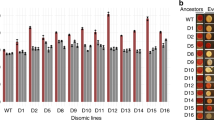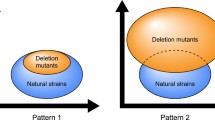Abstract
Genetic pleiotropy, the ability of a mutation in a single gene to give rise to multiple phenotypic outcomes, constitutes an important but incompletely understood biological phenomenon. We used a high-resolution and high-precision phenotypic profiling approach to quantify the fitness contribution of genes on the five smallest yeast chromosomes during different forms of environmental stress, selected to probe a wide diversity of physiological features. We found that the extent of pleiotropy is much higher than previously claimed; 17% of the yeast genes were pleiotropic whereof one-fifth were hyper-pleiotropic. Pleiotropic genes preferentially participate in functions related to determination of protein fate, cell growth and morphogenesis, signal transduction and transcription. Contrary to what has earlier been proposed we did not find experimental evidence for slower evolutionary rate of pleiotropic genes/proteins. We also refute the existence of phenotypic islands along chromosomes but report on a remarkable loss both of pleiotropy and of phenotypic penetrance towards chromosomal ends. Thus, the here reported features of pleiotropy both have implications on our understanding of evolutionary processes as well as the mechanisms underlying disease.




Similar content being viewed by others
References
Altschul SF, Lipman DJ (1990) Protein database searches for multiple alignments. Proc Natl Acad Sci USA 87:5509–5513
Caesar R, Blomberg A (2004) The stress-induced Tfs1p requires NatB-mediated acetylation to inhibit carboxypeptidase Y and to regulate the protein kinase A pathway. J Biol Chem 279:38532–38543
Chautard H, Jacquet M, Schoentgen F, Bureaud N, Benedetti H (2004) Tfs1p, a member of the PEBP family, inhibits the Ira2p but not the Ira1p Ras GTPase-activating protein in Saccharomyces cerevisiae. Eukaryot Cell 3:459–470
Cohen BA, Mitra RD, Hughes JD, Church GM (2000) A computational analysis of whole-genome expression data reveals chromosomal domains of gene expression. Nat Genet 26:183–186
Davidson JN, Chen KC, Jamison RS, Musmanno LA, Kern CB (1993) The evolutionary history of the first three enzymes in pyrimidine biosynthesis. Bioessays 15:157–164
Dudley A, Janse D, Tanay A, Shamir R, Church GM (2005) A global view on pleiotropy and phenotypically derived gene function in yeast. Mol Sys Biol 1:msb4100004–E4100001–msb4100004–E4100011
Finlay BB, Falkow S (1997) Common themes in microbial pathogenicity revisited. Microbiol Mol Biol Rev 61:136–169
Fisher RA (1930) The genetical theory of natural selection. The Clarendon Press Oxford
Giaever G et al (2002) Functional profiling of the Saccharomyces cerevisiae genome. Nature 418:387–391
Gu Z, Steinmetz LM, Gu X, Scharfe C, Davis RW, Li WH (2003) Role of duplicate genes in genetic robustness against null mutations. Nature 421:63–66
Hirsh AE, Fraser HB (2001) Protein dispensability and rate of evolution. Nature 411:1046–1049
Hirsh AE, Fraser HB, Wall DP (2005) Adjusting for selection on synonymous sites in estimates of evolutionary distance. Mol Biol Evol 22:174–177
Kamath RS, Ahringer J (2003) Genome-wide RNAi screening in Caenorhabditis elegans. Methods 30:313–321
Kellis M, Patterson N, Endrizzi M, Birren B, Lander ES (2003) Sequencing and comparison of yeast species to identify genes and regulatory elements. Nature 423:241–254
Lercher MJ, Blumenthal T, Hurst LD (2003) Coexpression of neighboring genes in Caenorhabditis elegans is mostly due to operons and duplicate genes. Genome Res 13:238–243
Lercher MJ, Urrutia AO, Hurst LD (2002) Clustering of housekeeping genes provides a unified model of gene order in the human genome. Nat Genet 31:180–183
Mewes HW et al (2002) MIPS: a database for genomes and protein sequences. Nucleic Acids Res 30:31–34
Otto SP (2004) Two steps forward, one step back: the pleiotropic effects of favoured alleles. Proc Biol Sci 271:705–714
Pal C, Hurst LD (2003) Evidence for co-evolution of gene order and recombination rate. Nat Genet 33:392–395
Preisig-Muller R et al (2002) Heteromerization of Kir2.x potassium channels contributes to the phenotype of Andersen’s syndrome. Proc Natl Acad Sci USA 99:7774–7779
Promislow DE (2004) Protein networks, pleiotropy and the evolution of senescence. Proc Biol Sci 271:1225–1234
Singleton P, Sainsbury D (2001) Dictionary of microbiology and molecular biology, 3 edn. Wiley Baffins Lane
Spellman PT, Rubin GM (2002) Evidence for large domains of similarly expressed genes in the Drosophila genome. J Biol 1:5
Thatcher JW, Shaw JM, Dickinson WJ (1998) Marginal fitness contributions of nonessential genes in yeast. Proc Natl Acad Sci USA 95:253–257
Wall DP et al (2005) Functional genomic analysis of the rates of protein evolution. Proc Natl Acad Sci USA 102:5483–5488
Warringer J, Blomberg A (2003) Automated screening in environmental arrays allows analysis of quantitative phenotypic profiles in Saccharomyces cerevisiae. Yeast 20:53–67
Warringer J, Ericson E, Fernandez L, Nerman O, Blomberg A (2003) High-resolution yeast phenomics resolves different physiological features in the saline response. Proc Natl Acad Sci USA 100:15724–15729
Author information
Authors and Affiliations
Corresponding author
Additional information
Communicated by A. Aguilera
Electronic supplementary material
Rights and permissions
About this article
Cite this article
Ericson, E., Pylvänäinen, I., Fernandez-Ricaud, L. et al. Genetic pleiotropy in Saccharomyces cerevisiae quantified by high-resolution phenotypic profiling. Mol Genet Genomics 275, 605–614 (2006). https://doi.org/10.1007/s00438-006-0112-1
Received:
Accepted:
Published:
Issue Date:
DOI: https://doi.org/10.1007/s00438-006-0112-1




